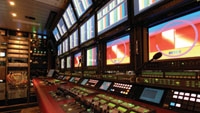Monitor walls

With increasing numbers of TV channels being processed and served on a growing number of delivery platforms, modern monitoring environments are changing beyond recognition. The engineers responsible for running today's playout facilities need the ability not just to monitor many more channels, but to adjust their viewing priorities quickly and easily, depending on the application.
In addition to quantity, quality has become a key issue. Broadcasters have been encouraged to invest in enhanced equipment and production facilities to provide the high-quality content that will entice consumers to make the leap to HD. With HD-ready display and projection technology penetrating more European homes, there are already signs that this investment is paying dividends. However, this places additional demands on the monitor wall, which needs to be capable of handling — and displaying — HD signals at a usable resolution.
Display technology
When designing a new monitor wall, the initial step is to consider the physical dimensions of the space being used. Today's monitor walls can vary in size from two or three 23in LCD panels to huge 3 × 3 arrangements of 50in rear-projection cubes.
These cubes, most of which use Texas Instruments' DLP technology, have the potential to deliver both the highest quality images and, because of their size, the greatest operational flexibility. They also require considerably more depth than LCD screens and generate more heat. The additional air-conditioning equipment needed will take up more space and may also raise the control room's noise floor.
If rear-projection is not an option, there is little reason to fear LCD. The initial resistance of some operators to LCD technology — largely based on image-quality grounds — has weakened as the screens themselves have improved. The increasing pixel count in displays means that a large number of sources can be displayed on one screen with minimum scaling required, maintaining picture detail.
In all other respects, there is no contest. An LCD wall in conjunction with a multiviewer system will always save on wall area, depth, weight and air-conditioning requirements compared with CRT. Further space savings can also be achieved, because ancillary equipment such as under monitor displays (UMDs), which indicate channel idents, on-air status lamps and studio clocks, can be virtualized by the multiviewer.
The modern video wall has become the hub of the control room, incorporating a multitude of monitoring functions alongside the video display, while providing a flexible, reconfigurable interface to the operator. The ability to reconstruct the wall at will, change layouts, and receive dynamically updated status information and automatic fault notification has quickly become a vital functionality for broadcasters.
Signal integrity measurements and data monitoring, previously performed by separate devices, are now found in the multiviewer, where the operator can recall their status to the monitor wall. Audio metering, channel IDs and tally status, once displayed on separate devices within the control room, are now routinely routed to the video wall.
However, the increasing number of channels makes it more difficult for operators to simultaneously observe the required number of sources. When designing a monitor wall, it is more important than ever to consider operator comfort. How many operators will typically need to sit at the wall? How far from the screens will they be? What control surfaces will they typically need easy access to?
Symptoms such as eyestrain and back strain are all too common in control rooms where functionality and ergonomics have not been properly considered at the design stage. Operators who are suffering from this kind of condition are more likely to miss key on-screen messages.
Adding an appropriately specified multiviewer to a monitor wall can help to alleviate these problems before they occur, because a multiviewer gives operators the flexibility to instantly resize and reposition images, depending on the playout schedule. With a multiviewer, operators no longer need to stretch to view a particular image because it is positioned too far away, or squint at a picture because the screen displaying it is too small to show sufficient detail.
Operator comfort is also a reason why, in large production centers, it has become necessary to automate the monitoring process, allowing the video wall to notify users of any errors or unexpected events. Often, it is also necessary to notify other pieces of software that may be used to control the entire production chain.
Source monitoring
Once purely simple screen splitters, multiviewers have evolved to meet this requirement, providing a host of monitoring capabilities. For example, new viewers offer extensive alarm capabilities. They are capable of detecting a large number of the technical faults most commonly encountered in a playout environment, and will automatically issue an on-screen alarm.
Video errors such as loss of video sync, frozen picture, black picture, EDH issues and missing ancillary data can be automatically detected. Audio errors, such as silence, over-level and phase error, can be continuously checked for, with any faults quickly rendered on screen, allowing the operator to react appropriately.
While the trend toward HD has been a key driver in the development of monitor walls, broadcast facilities are only gradually transitioning from SD to HD. Today's video wall needs to be capable of managing a mixture of video formats and aspect ratios, and designed accordingly. For example, a video wall must be capable of displaying 4:3 sources alongside 16:9 sources, as maintaining the correct aspect ratio is vital to avoid cutting elements from a picture.
The presence of 4:3 indicators on 16:9 sources is also a key requirement, to allow a production supervisor to view how an image will be displayed on different aspect ratio TVs in viewers' homes. With a multiviewer, the decoding of embedded aspect-ratio information can be used to automatically set the aspect ratio on sources, ensuring that the broadcaster has confidence in the source being presented correctly.
The more channels a video wall is charged with handling, and the greater the variety of sources for those channels, the harder it is for an operator to gain an instant overview of the state of play. In a crowded video wall, there is more emphasis on the ability to quickly identify a video window, and to quickly extract all status information for that source, such as video standard (PAL, SDI, HD-SDI), physical routing, logical name, channel ident, and other types of ancillary data embedded within the source.
Flexible layouts
Today's video wall has the advantage of being truly flexible. Where once a stack of CRTs was a fixed feature, the look and even style of a video wall can now be reconfigured as monitoring requirements change. For instance, “off-air” channels can be removed from view by switching between predefined layouts, and monitoring requirements can also vary to avoid raising unnecessary alarms. Flexibility of image sizing and positioning allows users to set their own priorities, enlarging important windows for quality assessment or displaying smaller windows from sources that are being shown for confidence monitoring only.
Incorporating a multiviewer solution as part of the build brings users an important step closer to the ideal of the truly virtual monitor wall. A multiviewer reduces the number of elements in a wall design that need to be fixed — both physically and operationally. But it is not the technological equivalent of a blank check. Careful consideration must still be given to the number of channels required, the format and resolution of the signals converging on the wall, the amount of audio monitoring needed, and so on.
As all monitoring is being brought to a single point by advances in video wall capabilities, reliability and redundancy are becoming of greater importance. Potential failure points in the transmission chain need to be kept to a minimum, and no facility can afford to lose monitoring, so the ability to reroute sources quickly from one monitor to another can be vital in emergencies.
The reliability of a multiviewer is crucial, and viewers should have dual-redundant power supplies so that in the unlikely event of a power supply failing, the power supply can be removed and replaced without the need to power down the system.
Video walls have evolved greatly in a few short years, and they are not finished yet. More sources and more information will find their way onto the wall, and building a modern wall is as much about predicting future trends as it is catering to contemporary challenges.
Kevin Jackson is product manager of broadcast and AV at Zandar Technologies.
Get the TV Tech Newsletter
The professional video industry's #1 source for news, trends and product and tech information. Sign up below.
